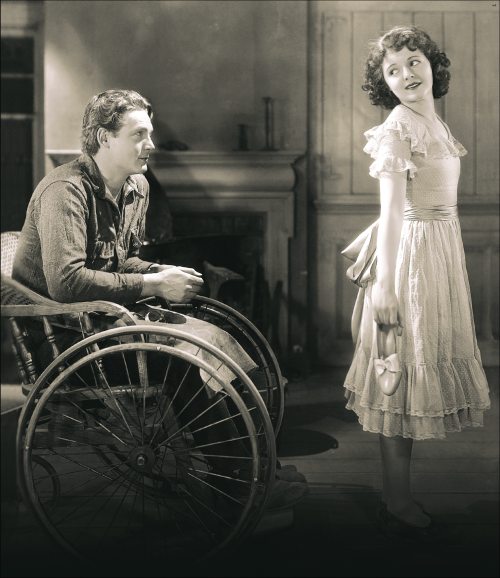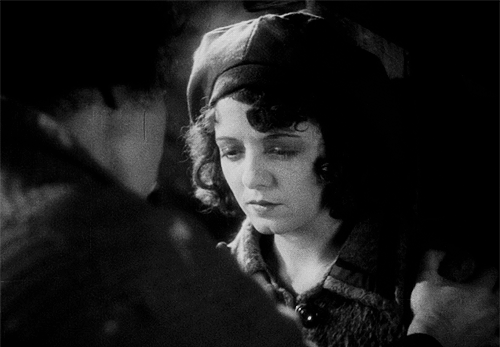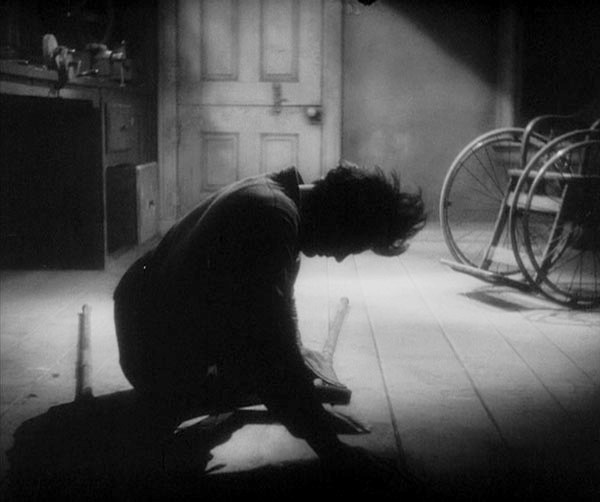A Primeira Guerra Mundial é um período
fantástico para ser estudado – e uma experiência terrível para ser vivida. Muitos
soldados que sobreviveram voltaram para casa desfigurados ou permanentemente
incapacitados. “Estrela Ditosa” conta a história de um destes soldados – e também
é provavelmente o único filme da história a ter uma briga entre duas pessoas no
topo de um poste de telefonia.
World War I is a fascinating period to be studied -
and a horrible experience to have been lived. Many of the soldiers who came
back returned permanently disabled or disfigured. “Lucky Star” is a story of
one of these soldiers - and also probably the only film ever to have two people
fighting while hanging up in a telephone line post.
Em uma área rural pobre vivem Mary e
Tim. Mary (Janet Gaynor) é uma garota que precisa cuidar dos irmãos mais novos
e ainda ajudar a mãe com as tarefas da fazenda. Tim (Chares Farrell) trabalha
consertando postes de telefonia, e com ele trabalha o preguiçoso Martin Wrenn
(Guinn Williams). Mary e Tim se conhecem quando ela entrega dois galões de
leite para os rapazes, e enquanto ela está lá tentando arrancar cinco centavos
a mais de Wrenn, Tim ouve a notícia de que foi declarada guerra.
In a poor rural area live Mary and Tim. Mary (Janet
Gaynor) is a girl who has to take care of her younger siblings and also help
her mom with the duties in the farm. Tim (Charles Farrell) works repairing
telephone posts, and his coworker is the lazy Martin Wrenn (Guinn Williams).
Mary and Tim meet when she delivers two gallons of milk to the boys, and while
she is in there trying to get an extra nickel from Wrenn, Tim hears the news
that war has been declared.
O primeiro encontro deles não foi
muito agradável. Quando Tim percebe que Mary estava mentindo sobre não receber
os cinco centavos de Wrenn, ele dá uma surra nela, e a deixa possessa. Mesmo
assim, ela sente falta dele e dos outros homens quando eles vão para a França.
Ela escreve para Tim e Wrenn, mas é mais educada com Wrenn. Mesmo na guerra,
Wrenn não mudou: ele não está interessado em seu dever cívico, mas sim em
conhecer moças francesas. O contraste é claro quando temos cortes rápidos entre
Wrenn, dirigindo um caminhão para encontrar mulheres, e Tim, usando um vagão
movido a cavalo para levar sopa para os
soldados nas trincheiras.
Their first encounter is not that pleasant. When
Tim realizes Mary was lying about not receiving Wrenn’s nickel, he spanks her,
and this drives her crazy. Nevertheless, she misses him and the other guys when
they leave to France. She writes to both Tim and Wrenn, but is more polite to
the later. Even in war, Wrenn hasn’t changed: he is not interested in his civic
duty, but in seeing French girls. The contrast is clear when we have quick cuts
between Wrenn, driving a truck to see the ladies, and Tim, using a wagon
propelled by a horse to take soup to the soldiers in the trenches.
Depois de um ano a França e outro ano
no hospital, Tim volta para casa em uma cadeira de rodas. Mary se surpreende ao
vê-lo assim, e fica mais surpresa ainda ao ver como ele já se adaptou à cadeira
de rodas – ele gira, vai para todo canto dentro de casa e até dá marcha à ré.
Mary começa a visitá-lo sempre, animada para ver as coisas que ele está
inventando. Tim primeiro quer protegê-la e zoá-la, como se faz com uma
irmãzinha, mas depois ele percebe que está apaixonado por ela.
After a year in France and another year in the
hospital, Tim comes home in a wheelchair. Mary is surprised to see him like
that, and even more surprised by how skilled he already is with the wheelchair
- doing loops, going everywhere inside his house and even moving backwards.
Mary starts going to his house often, excited to see the things he is doing as
an inventor. Tim first wants to both protect and tease her, as if she was a
younger sister, but then he realizes he is in love with her.
E Wreen ainda não aprendeu nada. Ele
foi expulso do exército, mas ainda usa seu uniforme – pior, ele diz à mãe de
Mary que foi promovido de sargento a major. Ele usa o uniforme e promessas
falsas de casamento para enganar garotas, e escolheu Mary como a próxima
vítima.
And Wrenn still hasn’t learned a thing. He was
expelled from the Army, but still wears the uniform – worse, he tells Mary’s
mother that he has been promoted from a Sergeant to a Major. He uses the
uniform and fake wedding promises to get girls, and he has chosen Mary as his
next victim.
Tim se entristece porque se sente
solitário. Ele fica em casa 24 horas por dia porque não há acessibilidade do
lado de fora. As coisas ficam ainda piores quando começa a nevar – algo que é
um desafio para as pessoas em cadeiras de rodas ainda hoje. Logo após a
Primeira Guerra Mundial, as cadeiras de rodas eram só cadeiras modificadas, e
fica claro que o modelo usado por Tim se popularizou a partir de 1880, por causa
da roda traseira. É prática, sim, mas não é suficiente para promover a socialização,
como o filme mostra.
Tim is sad because he is lonely. He is in his house
24/7 because there is no accessibility at all outside. Things get even worse
when it starts snowing – something that is still a challenge for people in
wheelchairs today. Right after World War I, the wheelchairs were just modified
chairs, and it’s clear that the model Tim has was common from the 1880s onward,
because of the rear wheel. Practical, yes, but not enough to promote the
socialization, as the film shows.
Tim não quer que as pessoas tenham
pena dele. E esta é a primeira coisa que precisamos saber ao lidar com
deficientes: eles não querem pena. Tratá-los de maneira diferente, especial, é
mais um insulto que um favor. Eles não querem privilégios. Eles querem ser tratados como seres
humanos, com algumas necessidades especiais. Mesmo que o termo “necessidades
especiais” não seja bem aceito, é a verdade: alguém como Tim, em uma cadeira de
rodas, precisa de algumas mudanças no local em que vivem para que possam viver
normalmente. Estas mudanças são pequenas, coisas que podem ser feitas
facilmente e que beneficiam a todos, porque conviver com pessoas diferentes é
enriquecedor para todos.
Tim doesn’t want people to pity him. And this is
the first thing we should know as we deal with the disabled: they don’t want
pity. Treating them in a different way, in a special way, is more of an insult
than a favor. They don’t want privileges. They want to be treated as human
beings, but with a few special needs. Although the term “special needs” is not
very cherished, it is the truth: someone like Tim, in a wheelchair, needs some
special changes in the place they live in order to live normally. Those special
changes are small changes, things that can be done and help everybody, because
socializing with different people is enriching for everybody.
Além de termos Tim convivendo com a
deficiência, temos Mary vivendo em uma família abusiva. Ela é explorada pela
mãe (Hedwiga Reicher) e apanha com frequência. A mãe também detesta Tim e o
chama de “aleijado”. Ela só está interessada nos presentes que Wrenn traz e nas
falsas promessas dele de dinheiro para a família se Mary se casar com ele.
Besides having Tim facing disability, we have Mary
living in an abusive household. She is exploited by her mother (Hedwiga
Reicher), and beaten by her. Her mother also dislikes Tim and calls him a “cripple”.
She is only interested in the gifts Wrenn brings and his empty promises of
money for the family if Mary marries him.
Charles Farrell era um ator muito
bonito, mas hoje está quase esquecido. Em “Estrela Ditosa”, ele mostra que
também era excelente ator. Seus esforços com as muletas me lembraram da atuação
de Lon Chaney, ao mesmo tempo difícil de ver e hipnotizante. Obviamente, para
que o roteiro funcione, o progresso de Tim é muito rápido, mas “Estrela Ditosa”
foi feito para ganhar dinheiro em cima da química da dupla Farrell e Gaynor, e
não para dar esperança para as pessoas que se tornaram deficientes após a
guerra.
Charles Farrell was a very handsome leading man,
even though forgotten today. In “Lucky Star”, he shows he also could act. His
efforts to use crutches reminded me of Lon Chaney’s acting, at the same time
painful to watch and hypnotizing. Of course, for the film’s sake Tim’s progress
is too quick, but Lucky Star was made to capitalize on the duo’s screen
chemistry, and not in order to give hope to people who became disabled after
the war.
A direção de arte é hipnotizante
desde o primeiro segundo de projeção. As casas podem ser pobres, mas são
construídas de maneira estilizada, e criam um contraste interessante com as
montanhas e o céu ao fundo. Borzage fez alguns filmes visualmente maravilhosos
nos anos 20 e 30 – eu particularmente aprecio o subestimado “Liliom”, de 1930. “Estrela
Ditosa” é mais um desses belos filmes.
The art direction is mesmerizing since the very
first second of the film. The houses may be poor, but they are built in a
stylized way, and make an interesting contrast with the mountains and the sky
in the background. Borzage made some visually beautiful films in the 1920s and
1930s - I particularly like the underrated “Liliom”, from 1930. “Lucky Star” is
another one in this list of beautiful films.
A “Estrela Ditosa” que conhecemos
hoje não é a versão original entregue pelo mestre Frank Borzage. De acordo com
resenhas de 1929, o filme era parcialmente falado, com efeitos sonoros e
diálogos perto do final. Entretanto, “Estrela Ditosa” foi considerado perdido
durante muitas décadas. Felizmente, uma cópia foi encontrada em um arquivo da
Holanda, e os intertítulos foram reconstruídos através de pesquisa e com ajuda
do roteiro original. Uma nova trilha sonora foi composta, mas infelizmente a
trilha original com diálogos ainda não foi encontrada.
The “Lucky Star” we have now is not the original
one delivered by master director Frank Borzage. According to reviews from 1929,
the film was a part-talkie with sound effects and dialogues near the end.
However, “Lucky Star” was considered completely lost for many decades. Luckily,
a print was found in the Netherlands Film Archive, and the intertitles were
reconstructed from research using the original screenplay. A new soundtrack was
composed, but unfortunately the original soundtrack with dialogue is yet to be
found.
“Estrela Ditosa” é uma das 12
colaborações entre Charles Farrell e Janet Gaynor. Eles eram tão convincentes
como um casal que vários presentes chegavam todas as semanas aos estúdios da
Fox para o “aniversário de casamento” deles. Obviamente, eles não eram casados.
E obviamente, um homem em uma cadeira de rodas não consegue se recuperar com
aquela rapidez. Mas “Estrela Ditosa” é um destes filmes em que devemos suspender
o senso muito crítico para apreciá-lo por completo. É belo, romântico
e nos dá esperança. Ditosos somos nós!
“Lucky Star” is one of 12 collaborations between
Charles Farrell and Janet Gaynor. They were so convincing as a couple that
several gifts arrived every week to the Fox Studios lot for their “wedding
anniversary”. Of course, they were not married. And of course, a man in a
wheelchair can’t recover that quickly. But “Lucky Star” is one of those films
that we must stop being too critical to enjoy. It’s beautiful, romantic and
gives us hope. Lucky us!
This is my contribution to the 2nd
Disability in Film blogathon, hosted by Crystal and Robin at In the Good Old Days of Classic Hollywood and Pop Culture Reverie.










Thanks for your contribution to the blogathon.
ReplyDeleteI had never heard of this movie before, so I'm glad you chose it. I like Borzage as a director. In my review of His Butler's Sister, I said, "What elevates this film is the lush, romantic direction by two-time Academy Award winner (7th Heaven and Bad Girl) Frank Borzage. The film glows with a soft, glimmering sheen. Borzage has a way of photographing faces that creates an emotional connection, not just between characters, but with the audience."
This is the film that turned me into a Janet Gaynor fan. Of course, I also love the chemistry between Gaynor and Farrell and wish more of their films were more readily available. Lucky Star is a film which made a big impact on me and one which I found extremely memorable. Thanks for a lovely review of this beautiful movie.
ReplyDeleteI adore Janet Gaynor and Charles Farrell together and I'm always impressed by Frank Borzage's artistic touches to a film. This is one I must see, and it thanks to your sensitive and insightful article.
ReplyDeleteI am starting to get into more silent movies, and this one sounds like I would like it! Nice review.
ReplyDeleteThank you so much for this post. This film seems fascinating for so many reasons. It sounds beautiful.
ReplyDeleteacabei de assistir e achei tão lindinho!!! é o tipo de filme que super imagino sendo feito hoje mas nunca pensei que já tivesse sido feito quase 100 anos atrás. e a química dos dois foi o que mais me prendeu no filme. agora vc ainda me diz que tem mais 11 deles juntos! hahahaha vou procurar mais alguns. obrigada como sempre pelas postagens!!!!
ReplyDelete